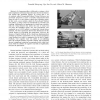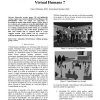235 search results - page 2 / 47 » Controlling Virtual Humans Using PDAs |
GI
2004
Springer
13 years 11 months ago
2004
Springer
: Humans have complex sensory and control capabilities. Only a few are used in standard games and virtual environments. Examples of games using interfaces beyond mouse, keyboard an...
ICRA
2007
IEEE
13 years 12 months ago
2007
IEEE
— In human-machine collaborative systems, robot joint compliance and human-input dynamics lead to involuntary tool motion into undesired regions. To correct this, a set of method...
CORR
2007
Springer
13 years 5 months ago
2007
Springer
– In the present paper, we introduce a new control architecture aimed at driving virtual humans in interaction with virtual environments, by motion capture. It brings decoupling ...
HERCMA
2001
13 years 7 months ago
2001
Interactive systems, games, VR and multimedia systems require more and more flexible Virtual Humans with individualities. There are mainly two approaches: 1) Recording the motion u...
BC
2004
13 years 5 months ago
2004
The dynamic characteristics of human upper extremities are usually expressed by mechanical impedance. Although many studies have discussed human impedance characteristics, there ar...


